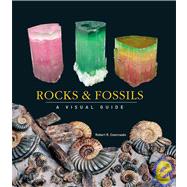
Note: Supplemental materials are not guaranteed with Rental or Used book purchases.
Purchase Benefits
What is included with this book?
Robert R. Coenraads is a leading gemologist, geologist and geophysicist. He travels the remotest regions of the globe to discover and collect exceptional specimens for scientific research. As a research associate of the Australian Museum, he leads rockhunting expeditions and directs exploration projects for precious gemstones and minerals.
| Introduction | |
| The Dynamic Earth Understanding rocks | |
| Reading the rocks | |
| Journey to Earth's center | |
| Rings of fire | |
| Spreading oceans | |
| Subduction Collision Earthquakes and faults | |
| Hot spots Understanding fossils | |
| The fossil record | |
| The five kingdoms | |
| Classification of fossils | |
| Evolution Adaptation Relating and mating Predators | |
| Avoiding predation | |
| Extinction Lifeforms and Earth's forces | |
| The divided continents Ancient Worlds Geological time | |
| Precambrian: first life | |
| Cambrian: explosion of life | |
| Ordovician: peak biodiversity | |
| Ordovician mass extinction | |
| Silurian: plants invade the land | |
| Devonian: the age of fishes | |
| Devonian mass extinction | |
| Carboniferous: the age of swamps | |
| Permian: end of an era | |
| Permian mass extinction | |
| Triassic: reptiles rise to dominance | |
| Triassic mass extinction | |
| Jurassic: rise of the dinosaurs | |
| Cretaceous: flowers bloom | |
| Cretaceous mass extinction | |
| Tertiary: age of mammals | |
| Quaternary: the age of humans | |
| After the next extinction | |
| Key Features | |
| How fossils form | |
| Types of fossils | |
| Trace fossils | |
| Reconstructing fossils | |
| Microfossils Rocks and their minerals | |
| How rocks form | |
| Rocks from melts | |
| Rocks from heat and pressure | |
| Layered rocks | |
| Rocks and Fossils in the Landscape | |
| Active volcanoes | |
| Eruptions Ashfalls Craters and calderas | |
| Historic volcanoes | |
| Lava Columns, spires and dikes | |
| Geysers Deltas Waterfalls and reiverbends | |
| Gorges and canyons | |
| Mesas, buttes and tors | |
| Deserts Beaches and coastal remnants | |
| Karst Caves Swamps, bogs and tar pits | |
| Ancient seabeds and lakebeds | |
| Fossil sites Folds and faults | |
| Glaciers and icefields | |
| Rocks from space | |
| Rock structures | |
| Minerals Understanding minerals | |
| Color, sheen and luster | |
| Optical effects | |
| Clarity and inclusions | |
| Crystal systems | |
| Habit Cleavage and fracture | |
| Identifying minerals | |
| Native elements | |
| Metallic minerals | |
| Evaporites Weathering | |
| Silicates Feldspars | |
| Crystalline quartz | |
| Cryptocrystalline quartz | |
| Opals Diamonds Emeralds and other beryls | |
| Sapphires and rubies | |
| Tourmalines and garnets | |
| Other gemstones | |
| Organic gems | |
| Fossils | |
| Fossils and living groups | |
| Plants Simple-celled fossils | |
| Sponges and their relatives | |
| Corals, jellyfish and anemones | |
| Brachiopods and bryozoans | |
| Mollusks and annelids | |
| Cephalopods Echinoderms | |
| Arthropods Fossils in amber | |
| Fishes Amphibians Reptiles Dinosaurs | |
| Dinosaur tracks and traces | |
| Pterosaurs and birds | |
| Mammals | |
| Humans Factfile | |
| Glossary | |
| Index | |
| Table of Contents provided by Publisher. All Rights Reserved. |
The New copy of this book will include any supplemental materials advertised. Please check the title of the book to determine if it should include any access cards, study guides, lab manuals, CDs, etc.
The Used, Rental and eBook copies of this book are not guaranteed to include any supplemental materials. Typically, only the book itself is included. This is true even if the title states it includes any access cards, study guides, lab manuals, CDs, etc.